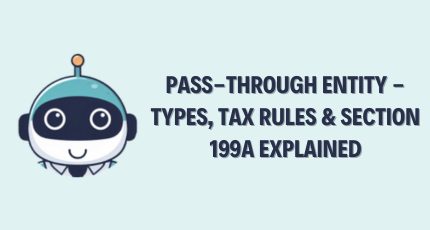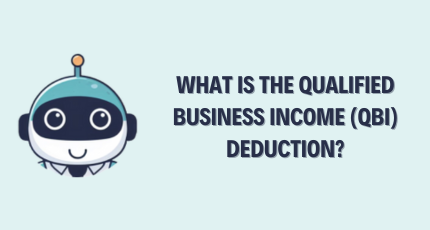Pass-Through Entity – Types, Tax Rules & Section 199A Explained

Pass-through entities offer one of the most tax-efficient ways to structure a business in the U.S., particularly for small to mid-sized business owners, professional service firms, and partnerships.
✅ TL;DR: Key Takeaways on Pass-Through Entities
- What is it? A pass-through entity lets business income flow directly to owners’ tax returns—avoiding double taxation.
- Entity Types: Includes sole proprietorships, partnerships, LLCs, and S-corporations.
- IRS Forms: Owners report income via Schedule C or E; entities file Form 1065 or 1120S with K-1s.
- Section 199A: Eligible owners may deduct up to 20% of Qualified Business Income (QBI).
- PTET Workaround: Over 30 states allow pass-through entities to pay state taxes directly to preserve federal deductions.
- State Conformity: States like Colorado and Utah conform to Section 199A; California and NJ do not.
- Best For: Small businesses, professionals, and firms not seeking venture capital or public stock offerings.
In this guide, we explain what pass-through entities are, the various types available, how pass-through taxation works, and how the Section 199A deduction applies—plus a breakdown of which states conform to this provision.
Table of Contents
- What is a Pass-Through Entity?
- What Are the Different Types of Pass-Through Entities?
- What is a Pass-Through Entity Tax (PTET)?
- What is the Section 199A Pass-Through Deduction?
- Which States Conform to IRC Section 199A?
- IRS Reporting Requirements for Pass-Through Entities
- Final Thoughts
- Pass-Through Entities FAQs
What is a Pass-Through Entity?
A pass-through entity is a business structure where income, deductions, and credits “pass through” the business and are reported directly on the individual tax returns of the owners. These entities do not pay federal income tax at the entity level.
Instead, each owner pays tax on their share of the income at their individual tax rate.
Why Is It Called “Pass-Through”?
The term refers to how the tax liability passes through the business and is absorbed by its owners. This avoids the double taxation faced by C-corporations, where income is taxed at both the corporate and shareholder levels.
What Taxes Do Owners Pay?
- Federal income tax on their share of profits
- Self-employment tax, depending on the entity type
- State-level taxes, where applicable
What Are the Different Types of Pass-Through Entities?
There are four main types of pass-through entities, each with different legal requirements, tax treatment, and setup procedures:
1. Sole Proprietorship
- Default structure for solo business owners
- Reported on Schedule C of Form 1040
- Unlimited personal liability
- No need for a separate business tax return
2. Partnership
- For two or more co-owners
- Files Form 1065 with the IRS
- Income split between partners via Schedule K-1
- Partners report their share of income on Form 1040
3. Limited Liability Company (LLC)
- Can be single-member or multi-member
- Default taxation is pass-through
- Can elect to be taxed as an S-corp or C-corp
- Offers limited liability protection and tax flexibility
4. S-Corporation
- Requires Form 2553 election with IRS
- Files Form 1120S and distributes Schedule K-1s
- Avoids double taxation
- Profits (after salary) may not be subject to self-employment tax
What is a Pass-Through Entity Tax (PTET)?
While pass-through entities avoid federal corporate income tax, some states have created a Pass-Through Entity Tax (PTET) to address the federal SALT deduction cap.
Why Does PTET Exist?
The Tax Cuts and Jobs Act (TCJA) capped the deduction for state and local taxes (SALT) at $10,000. To help business owners preserve deductibility, many states enacted PTET laws allowing the entity to pay state taxes directly—making them fully deductible at the federal level.
Which States Have PTET?
Over 30 states now offer a PTET workaround. Examples include:\n
What is the Section 199A Pass-Through Deduction?
Section 199A, also called the Qualified Business Income (QBI) deduction, allows eligible owners of pass-through entities to deduct a portion of their business income from taxable income.
- For tax year 2025: Owners can deduct up to 20% of qualified business income.
- For tax years after 2025: The deduction is expected to increase to 23% and be made permanent under the OBBB (“Big Beautiful Tax Bill”), per proposed and likely-enacted changes.
Who Can Claim the 199A or QBI Deduction?
- Sole proprietors
- S-corp shareholders
- Partners in partnerships
- LLC members (if the LLC is taxed as a pass-through)
Are There Limitations?
- Income thresholds: For 2025, above ~$182,000 (single) or ~$364,000 (married), the deduction begins to phase out. New legislation will adjust these amounts upwards for 2026 and beyond.
- Business type: Certain Specified Service Trades or Businesses (SSTBs)—such as law, accounting, and consulting—may face additional restrictions.
- W-2 wage tests: For high-income taxpayers, eligibility may depend on the amount of W-2 wages paid and/or the value of business property.
Example
A qualified business earning $200,000 may deduct up to $40,000 (20% of $200,000) from taxable income for 2025. For 2026 and later, the deduction would be $46,000 (23% of $200,000) under the expected new law.
Which States Conform to IRC Section 199A?
State conformity refers to whether a state has adopted the federal tax law provisions of Section 199A into its own income tax code.
| Conformity Status | States |
| ✅ States That Conform (Fully or Partially) | Colorado, Utah, Idaho, North Carolina, Alabama |
| 🚫 States That Do Not Conform | California, Massachusetts, New Jersey, Minnesota, Wisconsin |
📌 Note: Conformity may change annually. Always check your state’s Department of Revenue or CPA guidance for the most up-to-date alignment with IRC 199A.
IRS Reporting Requirements for Pass-Through Entities
Even though pass-through entities don’t pay federal income tax directly, they must still file returns and distribute income info to owners:
| Entity Type | IRS Filing Form | Owner Reporting Method |
| Sole Proprietor | Schedule C (Form 1040) | Included directly in the owner’s Form 1040 return |
| Partnership | Form 1065 + Schedule K-1 | Reported on Schedule E (Form 1040) |
| S-Corporation | Form 1120S + Schedule K-1 | Reported on Schedule E (Form 1040) |
| LLC (Default) | Same as above (based on election) | Based on tax election — can be treated as a sole proprietorship, partnership, or corporation |
Final Thoughts
Pass-through entities offer strategic tax savings and structural simplicity for many U.S. businesses. However, compliance requirements, QBI deduction eligibility, and state-level tax conformity can significantly impact outcomes. CPAs and business owners should review entity structure annually, especially in light of evolving tax law.
Pass-Through Entities FAQs
What is the main benefit of a pass-through entity?
It avoids double taxation by allowing income to be taxed only at the individual owner level.
Are pass-through entities taxed at the federal level?
No. They are informational filers. Owners report and pay tax on their allocated share of income.
Can an LLC be taxed as a pass-through entity?
Yes. By default, it is. But it can also elect to be taxed as a C-corp or S-corp.
Is the QBI deduction available to all owners?
Not always. It depends on income, business type, and whether wage limitations apply.
Do all states allow the 199A deduction?
No. State conformity varies. States like California and New Jersey do not allow the 199A deduction.
Want AI to Handle Tax Research + Compliance? Let CPA Pilot’s tax engine do the heavy lifting. Automate your 1040 research, pass-through compliance, and planning.

![Bonus Depreciation – Rules, Elections & State Conformity [2025 Guide]](https://www.cpapilot.com/blog/wp-content/uploads/2025/10/Bonus-Depreciation.png)



